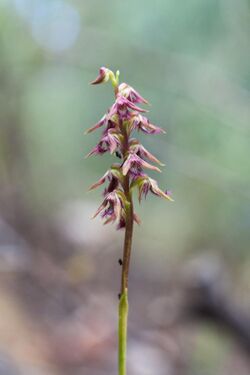Biology:Genoplesium ectopum
| Brindabella midge orchid | |
|---|---|

| |
| In the Namadgi National Park | |
| Scientific classification | |
| Kingdom: | Plantae |
| Clade: | Tracheophytes |
| Clade: | Angiosperms |
| Clade: | Monocots |
| Order: | Asparagales |
| Family: | Orchidaceae |
| Subfamily: | Orchidoideae |
| Tribe: | Diurideae |
| Genus: | Genoplesium |
| Species: | G. ectopum
|
| Binomial name | |
| Genoplesium ectopum | |
| Synonyms[2] | |
| |
Genoplesium ectopum, commonly known as the Brindabella spider orchid or ectopic midge orchid and as Corunastylis ectopa in Australia , is a small terrestrial orchid endemic to the Australian Capital Territory. It has a single thin leaf fused to the flowering stem and up to thirty five small, green and reddish purple flowers. It is only known from the Brindabella Range where it grows in Eucalyptus forest.
Description
Genoplesium ectopum is a terrestrial, perennial, deciduous, herb with an underground tuber and a single thin leaf 100–250 mm (4–10 in) and fused to the flowering stem, the free part 15–20 mm (0.6–0.8 in) long. Between fifteen and thirty five green and reddish purple flowers are arranged along a flowering stem reaching to a height of 20–40 mm (0.8–2 in) long and much taller than the leaf. The flowers are about 5 mm (0.2 in) long and wide and are inverted so that the labellum is above the column rather than below it. The dorsal sepal is 3–4 mm (0.1–0.2 in) long and about 2.5 mm (0.1 in) wide. The lateral sepals are 4–5 mm (0.16–0.20 in) long, about 1.5 mm (0.06 in) wide, with a humped base and spread apart from each other. The petals are about 3 mm (0.1 in) long and 1 mm (0.04 in) wide with a few hairs on their edges. The labellum is purple, about 4 mm (0.2 in) long, 2 mm (0.08 in) wide with coarse hairs up to 2 mm (0.08 in) long and the labellum vibrates in the slightest breeze. There is a callus in the centre of the labellum but not extending to its tip. Flowering occurs from January to March.[3][4]
Taxonomy and naming
Genoplesium ectopum was first formally described in 1999 by David Jones from a specimen collected in the Brindabella Ranges and the description was published in The Orchadian.[1] In 2002, Jones and Mark Alwin Clements changed the name to Corunastylis ectopa.[5] The specific epithet (ectopum) derived from the Ancient Greek word ektopos meaning "out of place".[6]
Distribution and habitat
The Brindabella midge orchid is only known from a single site in the Brindabella Range at an altitude of 980 m (3,000 ft) where it grows in Eucalyptus forest.
Conservation
The entire population of this midge orchid grows within 10 m (30 ft) of a road embankment prone to erosion. Population estimates range from about 35 following bushfires and drought, to the present at about 110. The main threats to the species are erosion, roadworks, weed invasion, shrub growth and inappropriate use of herbicides. The species is listed as "critically endangered" (CR) under the Environment Protection and Biodiversity Conservation Act 1999 (EPBC Act).[4][7]
References
- ↑ 1.0 1.1 "Genoplesium ectopum". APNI. https://id.biodiversity.org.au/instance/apni/581212. Retrieved 2 February 2018.
- ↑ "Genoplesium ectopum". World Checklist of Selected Plant Families (WCSP). Royal Botanic Gardens, Kew. http://wcsp.science.kew.org/namedetail.do?name_id=89170.
- ↑ Jones, David L. (2006). A complete guide to native orchids of Australia including the island territories. Frenchs Forest, N.S.W.: New Holland. p. 177. ISBN 1877069124.
- ↑ 4.0 4.1 Frawley, Kevin. "Recovery Plan For Brindabella Midge Orchid (Corunastylis ectopa)". Australian Government Department of the Environment. http://www.environment.gov.au/system/files/resources/30fa8209-e733-494d-9de8-5b9d148f0f09/files/corunastylis-ectopa.pdf. Retrieved 2 February 2018.
- ↑ "Genoplesium ectopa". APNI. https://id.biodiversity.org.au/instance/apni/581179. Retrieved 2 February 2018.
- ↑ Brown, Roland Wilbur (1956). The Composition of Scientific Words. Washington, D.C.: Smithsonian Institution Press. p. 612.
- ↑ "Brindabella Midge Orchid (Corunastylis ectopa)". ACT Government Directorate of Environment. https://www.environment.act.gov.au/cpr/conservation_and_ecological_communities/threatened_species_action_plans/threatened-species-action-plans-downloads/downloads/brindabella-midge-orchid-corunastylis-ectopa. Retrieved 2 February 2018.
External links
Wikidata ☰ Q15464246 entry
 |


